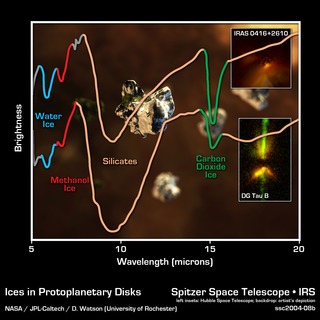
Credit: Credit: NASA/JPL-Caltech/D. Watson (University of Rochester)
Chart • May 27th, 2004 • ssc2004-08b1
ssc2004-08b1
Using sensitive instruments onboard NASA's Spitzer Space Telescope, scientists have seen the first building blocks of planets, and possibly future life, deep within dusty discs around young stars. The image shows spectra, obtained by Spitzer's infrared spectrograph, of two stars that are so young they are still embedded in protoplanetary discs. These thick discs of gas and dust are the leftover material from the formation of the stars themselves. The spectra are graphical representations of a celestial object's unique blend of light. Characteristic patterns, or fingerprints, within the spectra allow astronomers to identify the object's chemical composition.
In both infrared spectra, the presence of important chemicals for the formation of new worlds can be seen clearly. The broad depression in the center of each spectrum signifies the presence of silicates, which are chemically similar to beach sand. In fact, a good match for the chemistry of these crystalline silicates may be the famous green beaches of Hawaii, which get their color from olivine crystals in the sand. The depth of the silicate absorption feature indicates that the dusty cocoon surrounding the embedded protostar is extremely thick. Other absorption dips are produced by water ice (blue), methanol ice (red), and carbon dioxide ice (green). The fact that water, methanol and carbon dioxide appear in solid form suggests that the material immediately surrounding the protostar is cold.
About the Object
- Name
- DG Tau B • IRAS 0416+2610
- Type
- Star > Circumstellar Material > Disk > Protoplanetary
Color Mapping
| Band | Wavelength | Telescope |
| Infrared | Spitzer IRS |





